Do you have some antique gold jewelry or a few vintage gold rings sitting in your jewelry box that you never wear?
Maybe you inherited the jewelry or acquired it long ago and know next to nothing about it. If these are not pieces that you currently wear, it might be time to consider selling or refining your gold or other precious metal.
Should I sell my gold jewelry now? Gold is at an all time high at $2,343.10 per ounce (April 26, 2024). Now might be the time to think about monetizing those pieces sitting around collecting dust and purchasing those old mine cut diamond earrings you’ve been eyeing.
IS YOUR ANTIQUE JEWELRY WORTH KEEPING: HOLD, SELL, OR REFINE?
Before you do anything, you should try to figure out what you have.
Jewelry is considered to be antique when it is 100 years or older. So looking back from 2024, anything made during or before 1924 (the Art Deco Period) would be classified as antique. Some antique jewelry will increase with value over time. In fact, you may find that some of the antique jewelry sitting your jewelry box has in fact become more valuable since you acquired it.
Unfortunately, most modern, unsigned jewelry does not appreciate over time. In fact, if you decide to sell this type of jewelry you are likely to receive only a fraction of the price that you paid for it.
INTRODUCTION: SCRAP VALUE AND REFINING
Before we delve into antique jewelry identification, here are a few basics on refining. You’ve probably heard the term “scrap value” before. In this context, it refers to the value of the precious metal contained in a piece of jewelry. This is determined by the amount of precious metal and the current spot price of the metal.
I would only recommend refining or scrapping jewelry if you have considered the following:
- It is damaged and not worth repairing.
- It is a piece that has no other value above its intrinsic value.
- You have tried to monetize it in other ways (optional).
- You have or will remove any gemstones that have value on their own.
If your goal is to sell your jewelry quickly, then refining could be the best option. The timeline is closer to a few days rather than the weeks or months it may take to monetize it through other routes.
ANTIQUE JEWELRY IDENTIFICATION: LOOKING FOR MARKS
You can do a little detective work on your own, or you can take it straight to the professionals.
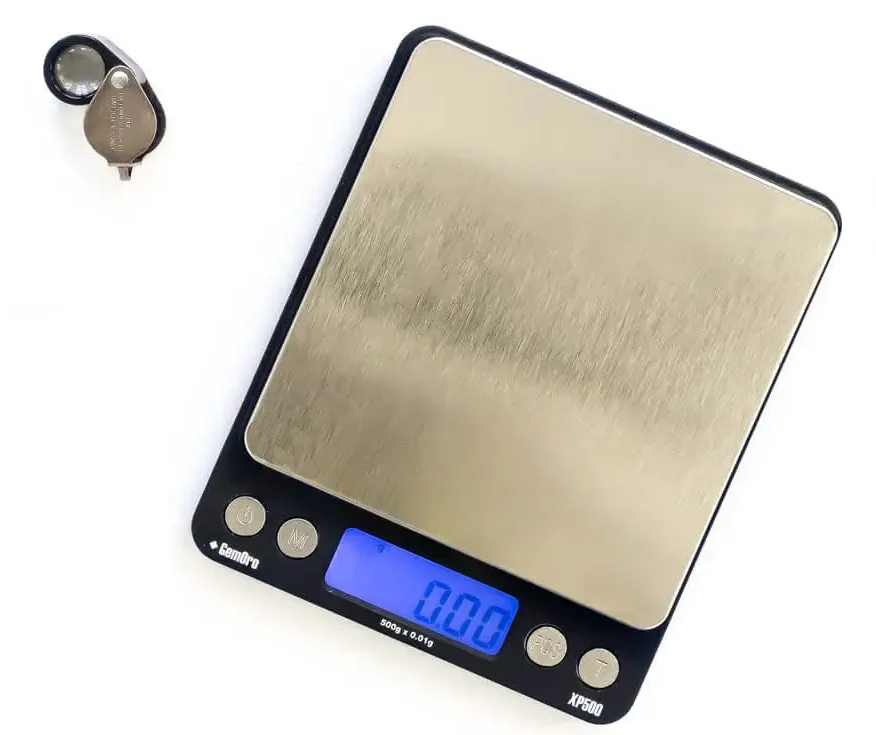
To get started, look for stamps or marks that might tell you about the purity of the metal, what country it was made in, or even the year. A jeweler’s loupe is a big help. It may help you find a hallmark, purity mark, or maker’s mark on your jewelry that you never knew was there.
A jeweler’s loupe and a scale are two inexpensive tools that can help you with your preliminary analysis.
If you find something you think might be a hallmark, take a photo and give Google Lens a try. Google Lens is an image recognition app that identifies the object in an image, searches the web, and attempts to match it to similar results.
The images below are examples of a set of English Hallmarks found on a Georgian Mourning Ring: a purity mark (18ct), a city mark (London) and a date mark (1825). If you’d like to learn more about your hallmarks, take a look at Guide: Interpreting Hallmarks on Jewelry.
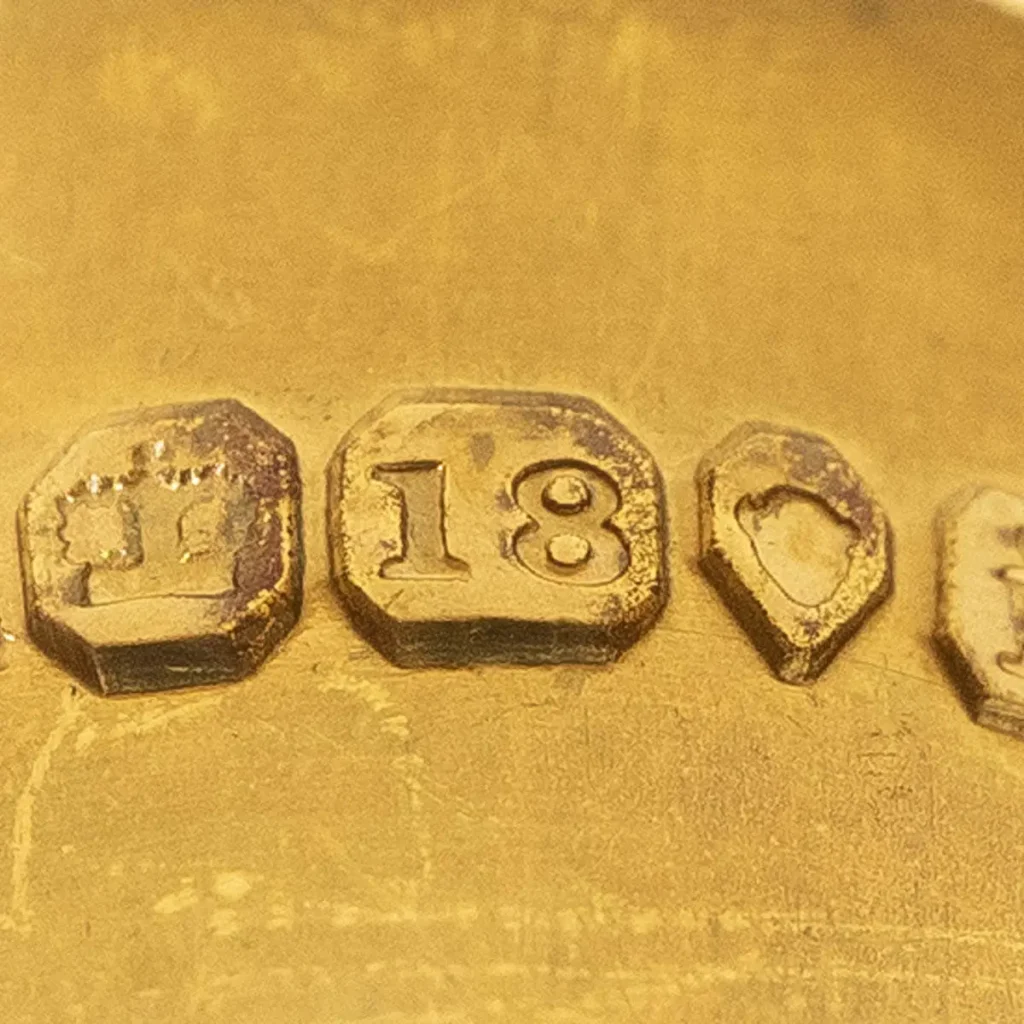
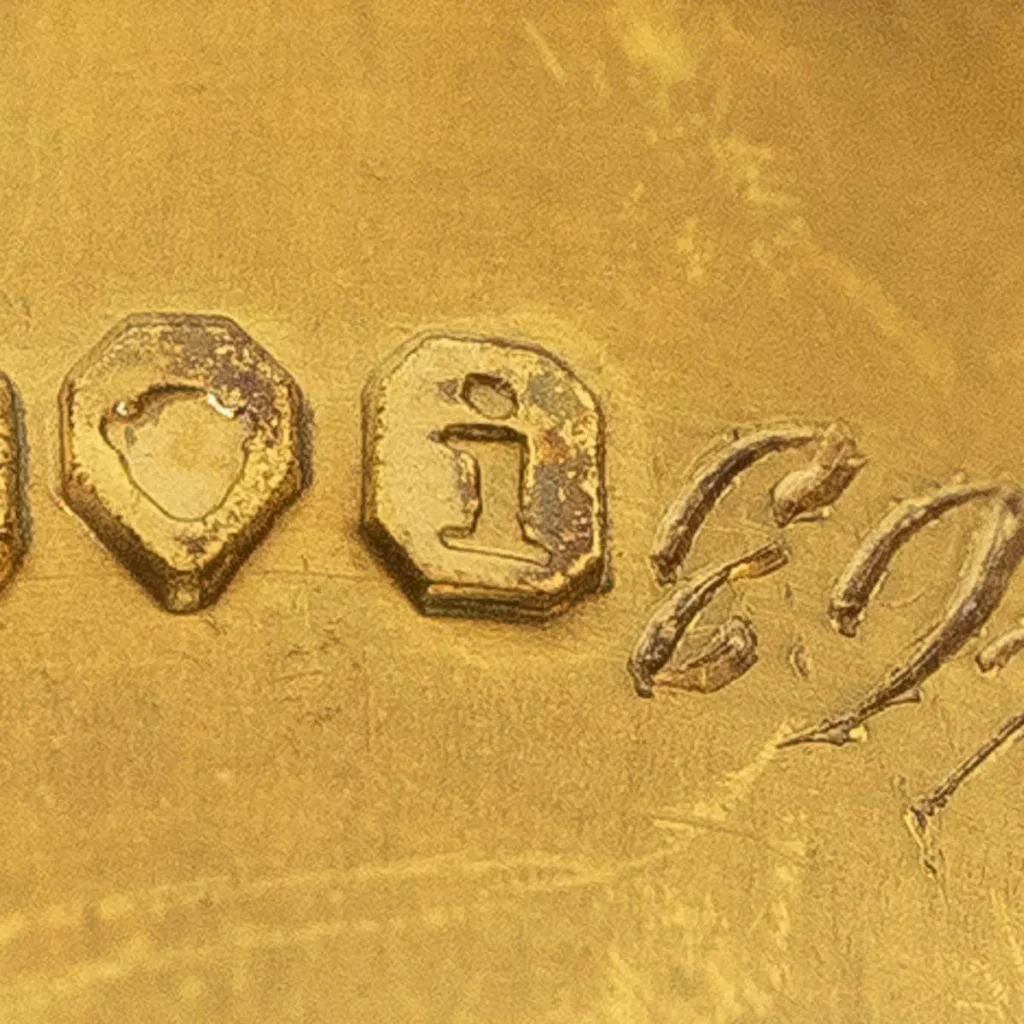
If you find a gold purity mark or just numbers, the table below can help you determine what percentage of your jewelry is gold.
You might also discover a maker’s mark, which can be initials or the full name of the maker. While most of us have heard of Tiffany’s or Cartier, you might be surprised by the maker’s mark. A name that you have never heard of might add significant value.
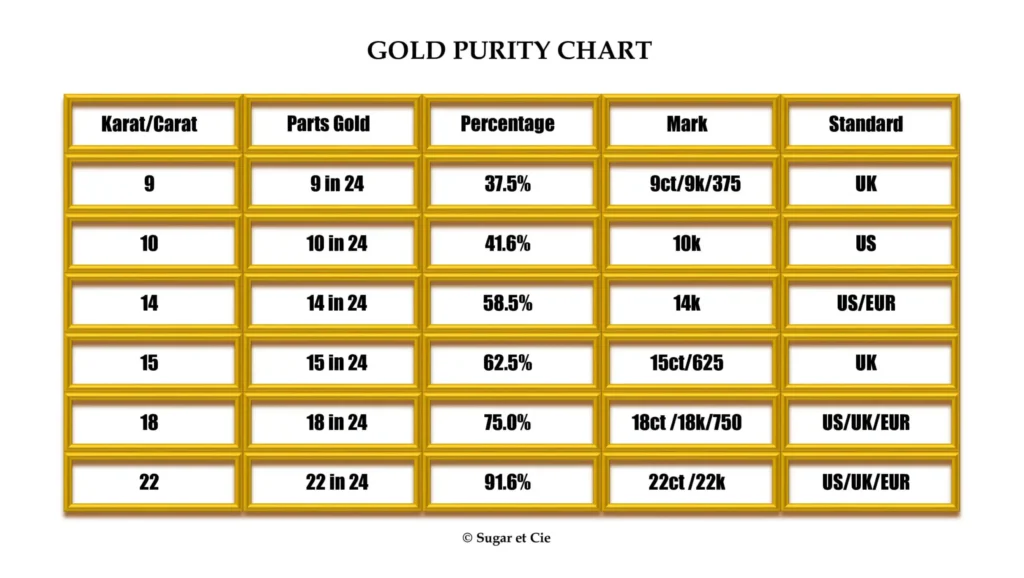
Find out how much your piece of jewelry weighs. While this is not the only factor in determining value, it does matter.
LOOKING FOR COMPARABLE PIECES
Try to see if you can find a piece of jewelry that is similar to yours. If you can’t come up with a good search description, I would again suggest taking a picture and letting Google Lens get you started.
At some point you may need professional advice. Here’s why.
You might find an item that you think is similar, but a professional may tell you that what you think is a diamond ring from the 18th century is actually a 20th century reproduction. Or conversely, a simple gold chain that you thought was neither old nor valuable could in fact be circa 1800 and worth multiples of its scrap value.
Auction House Valuation Days
Auction houses in your area may have Valuation Days where they allow you to bring in a few pieces of jewelry to get more information. Some might even provide this service virtually via pictures. The information you receive will vary quite a bit depending on the Auction House, but it is a good place to start and there is no charge.
Look for an Auction House that has a Jewelry Department. Or better yet, browse through their past catalogues to see if they have a history of offering antique jewelry. Finally, keep in mind that this is a verbal opinion without guarantees, and that not all experts are in fact (ahem) experts.
Jewelry Appraisal – What Kind?
If you think you have something of value and want to know more, consider obtaining an appraisal. Keep in mind that an appraisal will help you understand what you have, but it won’t necessarily provide you with the value that you could achieve if you decide to sell it.
A few tips. Don’t be afraid to compare fees or get quotes from multiple appraisers. If you think you have an antique piece of jewelry, look for an appraiser that has expertise in antique jewelry. Not all appraisers have the same qualifications.
Also think through the basis for value. Why are you getting the appraisal? Is it for insurance?
- Insurance (Replacement Value For Insurance Purposes): The realistic cost to replace the item. This will always be at the high end of the range.
- Fair Market Value (e.g. Estate Appraisal, Charitable Donation): Reflects the price likely to be arrived at by a willing buyer and a willing seller, when time is not a factor.
- Immediate Liquidation (Wholesale): This is the low end of the range. Time is a constraint.
HOW AND WHERE TO SELL (CONSIGN)
Simply put, the more effort you put into the process, the greater the value you are likely to realize.
If you have a piece of jewelry that is mostly made of precious metal with no stones or very few small stones (of de minimis value), arm yourself with the knowledge of its scrap value. This is the minimum value.
If you don’t have the knowledge or ability to sell the piece yourself, the next best thing in my opinion is consignment where the seller takes an agreed upon percentage of the selling price (in the 10% to 20% range). This will get you close to the fair market value without having to do the actual marketing and selling. This is likely to be better than the wholesale value you’ll be offered by a jewelry store or others that want to buy your jewelry.
AT AUCTION
Look for an auction house that specializes in antique jewelry and that has both online and in-room bidding. You will reach a larger target market. Auction houses usually take in the neighborhood of 20%. If you pursue this, you should understand all of the terms and conditions for the sale including reserve price, other fees, liability etc.
CONSIGNMENT: A JEWELRY STORE WITH AN ESTATE COLLECTION
Don’t confuse consigning with selling. As mentioned, if you “sell” your jewelry to a jewelry store, you will most likely get wholesale value. If you are lucky, you might find a jewelry store that not only sells estate and antique jewelry, but is also willing to take your jewelry on consignment.
At a minimum, you’ll need to agree upon a selling price, consignment commission, and term (how long they can keep your pieces). Be sure to find out if your jewelry will be covered by their insurance while it is in their possession.
Of course there are other online platforms and methods for selling your jewelry, but in my experience when you weigh effort, knowledge, and value, these options are likely to be your best bet.
HOW AND WHERE TO REFINE YOUR GOLD & OTHER PRECIOUS METALS
So you’ve decided to refine your jewelry. What else do you need to know?
WHY YOU SHOULDN’T CHOOSE “CASH FOR GOLD”
I would not recommend choosing a place that offers to pay cash for gold that is not a refinery, and here’s why. Businesses who offer “Cash for Gold”, pawn shops, and others are middlemen or facilitators. And like any other business, they need to make a profit. They will take a percentage for their service and you are likely to net less. What you might gain in convenience, you lose in value.
You may not be aware that some refineries will work with you directly. When you work directly with a refinery like Garfield, you will likely achieve a higher payout.
This might be a good time to mention that this is not an affiliate post. I am not receiving any compensation for highlighting Garfield Refining. I found Garfield through my own independent research, and it is currently the refinery I use. I enjoy sharing my knowledge with my customers and others that might not be privy to the nuts and bolts of the jewelry industry.
CAN I CALCULATE A PRELIMINARY VALUE OF MY REFINED GOLD?
Yes, you can. Here’s what you’ll need to know: metal purity, weight, spot price, and the percentage that the refinery is willing to pay you for your precious metal.
GOLD SCRAP CALCULATION
Let’s take the following example: A vintage gold ring. The ring is stamped 18k. It is thick and weighs 10 grams.
Troy Ounce. The Gold Spot Price is based on price per troy ounce, which is different from a standard ounce. There are 31.1035 grams per troy ounce.
Spot Price. The spot price per ounce of gold on April 26, 2024 was $2,343.10.
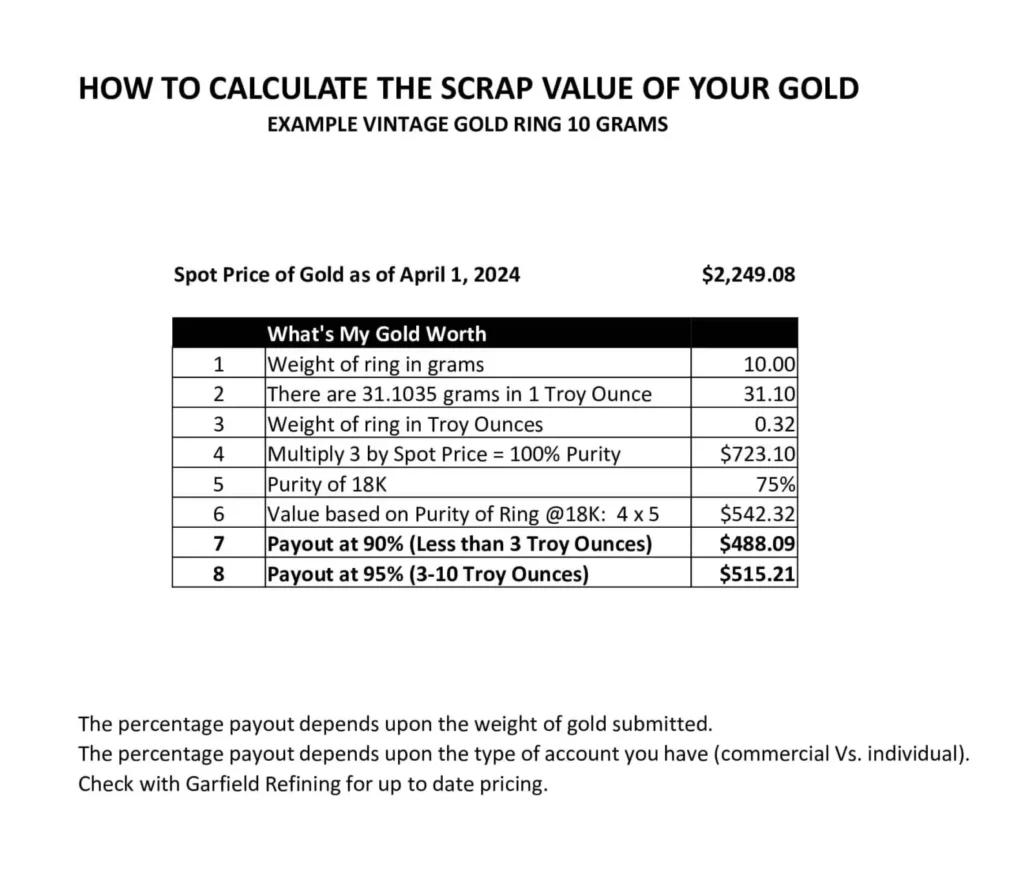
This should at least give you an idea of the value, typically referred to in the industry as the “scrap value” of your gold. Keep in mind that you might not receive the amount that you originally calculated, as the weight and/or purity you used may not have been completely accurate.
WHICH PATH WILL YOU CHOOSE?
Each option has its pros and cons. And whether you choose to keep, sell, or refine your jewelry, the more you know, the better results you’ll inevitably achieve.
If you’d like to learn more about Garfield’s gold refining process, take a look at 5 Tips for Choosing a Gold Refinery Near You or their FAQ.
Written by Leah Roth
Leah is the founder of Sugar et Cie, an eCommerce luxury brand that offers a carefully curated collection of fine jewelry and home accessories. A jewel hunter by day and growth hacker by night, Leah is always looking for the next spectacular find. Leah has 10 years of experience in evaluating fine antique jewelry. Prior to founding Sugar et Cie, she was an executive within the technology industry.
Sugar et Cie specializes in French and English antiques from the Georgian Period through the Art Deco period and beyond.

